Category Archives for "Uncategorized"
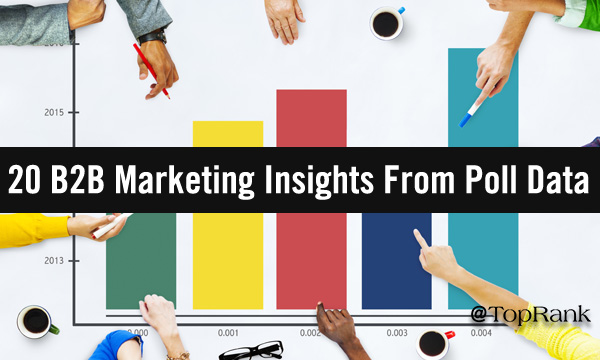

What can poll results tell B2B marketers about a year unlike any other, and how can this valuable audience data help us refine our marketing strategy as we push towards 2021?
For more than a year we’ve run weekly social media polls on our Twitter profile, and for several months now have simultaneously also placed a weekly user poll on our LinkedIn* page.
We wanted to share some of the fascinating insights you have shared with us in the form of results from our polls, in order to see the trends that have emerged during this unprecedented year.
Let’s look at trends in social media communications, how marketing is changing in 2020, and the rising effectiveness of B2B influencer marketing, all through the lens of poll-derived feedback.
How quickly do we expect a response from a brand when we ask a question publicly on social media?
The majority marketers we polled expect to hear back from a brand within 24 hours, with 61 percent of respondents on LinkedIn expecting a reply within a day, 24 percent within one hour, and 16 percent by the end of the workday.
Twitter respondents voiced similar sentiments, with 38 percent looking to get a reply from a brand within 24 hours, 33 percent by the end of the current workday, and 21 percent within an hour.
If you’re not answering social media inquiries within 24 hours you may come under fire, as not even one respondent to our poll said that they expect brands to take longer than a day to reply.
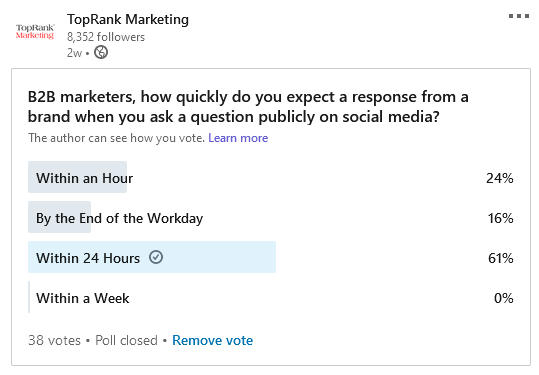
We also asked the same question for a different form of online communications, curious about expectations when sending an old-fashioned email to a brand.
50 percent of our Twitter poll respondents said that they expected an email reply within 24 hours, mostly echoing the expectations for public social media questions. 22 percent said they expected brands to reply by the end of the workday, 18 percent within a week — a notable difference from social media queries — and just 9 percent within an hour.
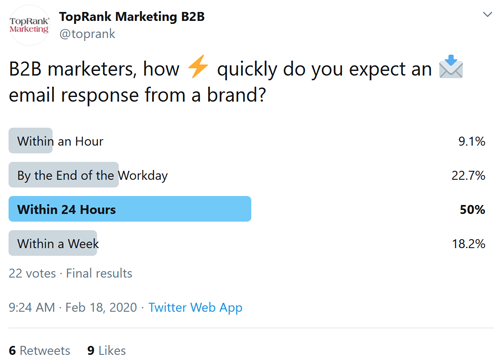
What drives people who have already taken the time and effort to follow a brand on social media to later unfollow them, and what messages can we learn from these mistakes?
When we asked this question in a poll, our LinkedIn respondents said the top reason they unfollow brands comes down to posting poor quality content, followed by irrelevant content and brands that post too much content. Just two percent of respondents said that they unfollow brands that don’t post enough content.
44 percent of our Twitter respondents said that irrelevant content was their top reason for unfollowing a brand, followed by poor quality content at 33 percent, and too much content at 22 percent.
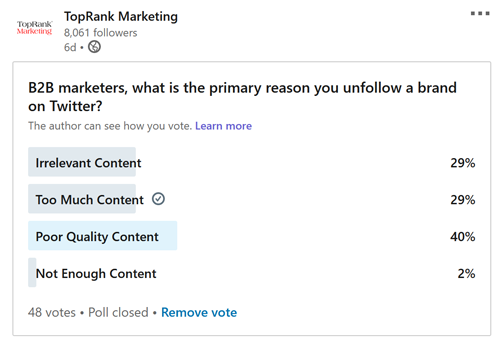
We also ran a poll asking how the ephemeral stories format would fare on LinkedIn if the platform were to make its test of the post type a permanent part of the service. 33 percent of respondents said that LinkedIn Stories would be a great addition to the platform, while 25 percent felt it would be a good match. 25 percent also said that it would be an unlikely match, and 16 percent noted that the stories format would be a poor match for LinkedIn.
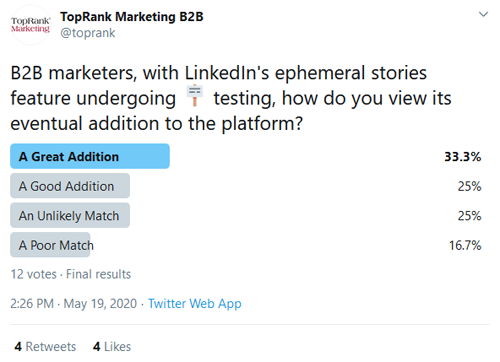
We were also curious how B2B marketers are using experiential content in 2020. 58 percent of our Twitter poll respondents said that they expected to incorporate experiential content very frequently into their marketing efforts during 2020, followed by 41 percent who planned to do so somewhat frequently.
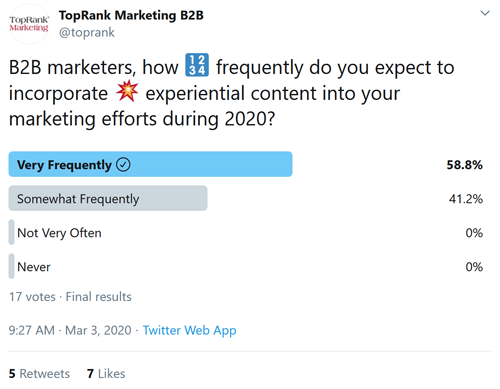
Experiential content is playing a greater role in B2B marketing efforts in 2020, which I looked at in “What B2B Marketers Need to Know About Experiential Content,” and our Nick Nelson examined recently in “How to Hit a Marketing Home Run with Experiential Content.”
How B2B marketers communicate is constantly shifting as new technologies become available and gain wider adoption. We asked our Twitter followers who use chatbots or other forms of messaging featuring artificial intelligence (AI) to chime in on how the technology has performed for them.
49 percent of B2B marketers who responded said that chatbots and AI-assisted technology has performed better than expected, yet 42 percent noted that the technology has under-performed, while 14 percent found that it performed as they had expected.
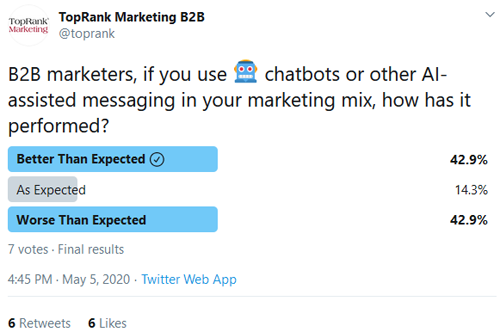
We were curious what our audience of B2B marketers on Twitter felt the most effective length of time might be when it comes to virtual meetings.
58 percent of respondents said that 30 minutes was the optimal length of time for effective virtual meetings, while 17 percent felt that 15 minutes or less works best, with 17 percent also noting that 45 minutes is the most effective, followed by just 5 percent who said an hour was best.
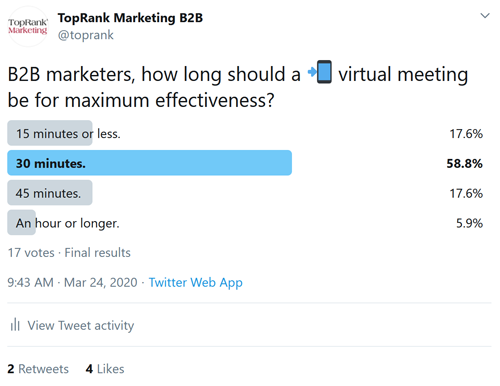
Another part of marketing communications is user feedback, reviews, and testimonials, and we asked our Twitter followers to share how often they use positive reviews in their marketing efforts.
47 percent of respondents said that they use positive reviews in their marketing efforts occasionally, however 23 percent noted that they never do, followed by 17 percent who said that they always do, and 11 percent who do so frequently.

Speaking of email, we also wondered when B2B marketers prefer to receive monthly newsletters. 45 percent of our respondents said they prefer the first of the month, followed by 27 percent who are fond of mid-month newsletters, 18 percent who prefer a time early in the month, and 9 percent who want to see newsletters arrive at the end of the month.
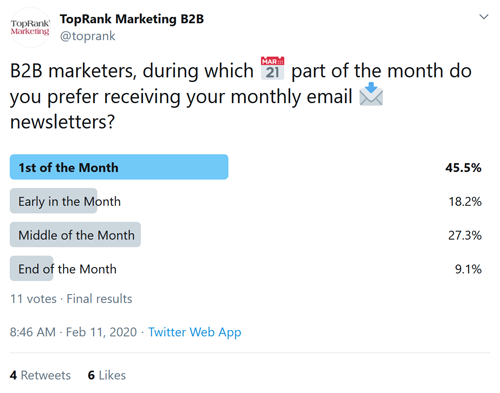
The use of emojis in social media messaging was an area of contention among our poll respondents. 35 percent said that emoji were somewhat effective, while the same number noted their use to rarely be effective. 17 percent said emoji were extremely effective, and some 11 percent noted that they never use them.
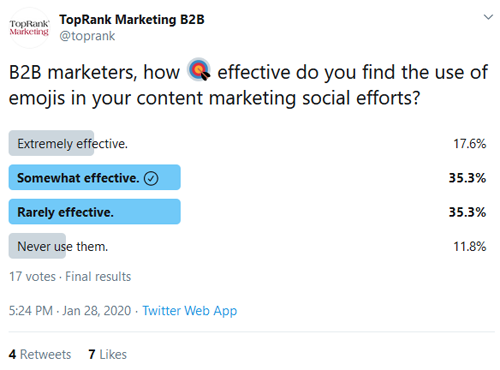
The global health crisis has changed the face of marketing events in 2020, as nearly all conferences have made the jump to virtual events, as I wrote about recently in “17+ Top Virtual Marketing Conferences for Summer 2020 & Beyond.”
Are B2B marketers planning to attend newly-virtual events, and if so how many?
We asked our LinkedIn and Twitter users how many virtual marketing events they planned to attend over the final five months of 2020.
Most respondents said that they will attend between one and five virtual marketing events, while the second most frequent choice was those who said they won’t be attending a single virtual event, followed by those who plan to attend between six and 10.

Virtual events and webinars are undoubtedly seeing an unexpected golden age this year, and we’ve explored how to best utilize them, in “How B2B Marketers Can Get the Most Out of Webinars in 2020.”
[bctt tweet=”“One great way to promote the webinar, and focus your content at the same time, is to poll your audience via social media. Ask for their thoughts on your topic. Ask what they most want to know about it.” @NiteWrites” username=”toprank”]We wanted to find out what the biggest pandemic pain points have been for B2B marketers, and among those answering our LinkedIn poll 64 percent said that a decrease in budget or business has been the top challenge, followed by the difficulty in engaging customers at 36 percent.
46 percent of Twitter respondents also revealed that falling budgets and business were their top pain points, followed by engaging customers at 38 percent and remote work issues for some 15 percent of marketers.
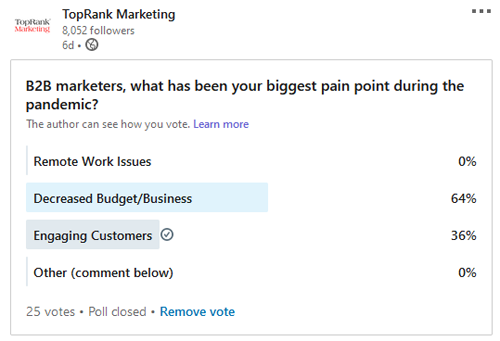
63 percent of poll respondents said that they have used their time during the pandemic to learn new marketing skills online, while 18 percent said that they planned to do so.
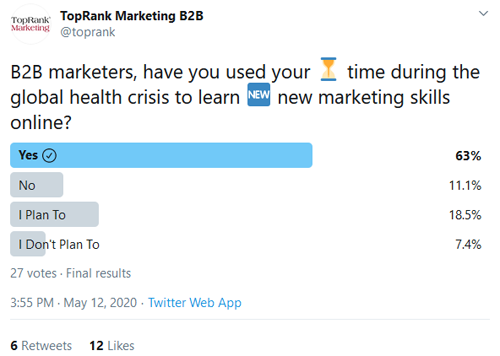
54 percent of B2B marketers we polled on Twitter said that they either already use a digital asset management (DAM) solution in their marketing stack or plan to implement one, while 45 percent didn’t use a DAM.
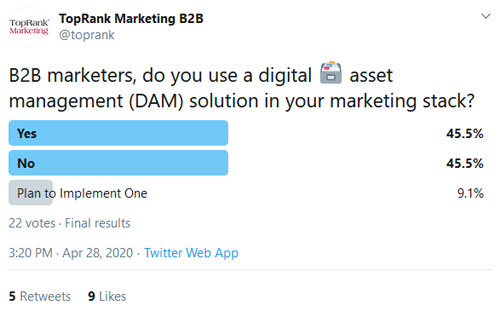
If you aren’t familiar with how DAM can help B2B marketers, I looked into the issue in “Why B2B Marketers Should Give a DAM: Top Tips on Digital Asset Management.”
With U.S. podcast listeners topping the 100 million mark for the first time in 2020, we wondered how the global health crisis has affected listening frequency among B2B marketers.
40 percent of our Twitter respondents said that they have been listening to more podcasts during the pandemic, with 22 percent noting that they’ve listened to fewer, 18 percent about the same amount, and another 18 percent who said they don’t listen to podcasts.
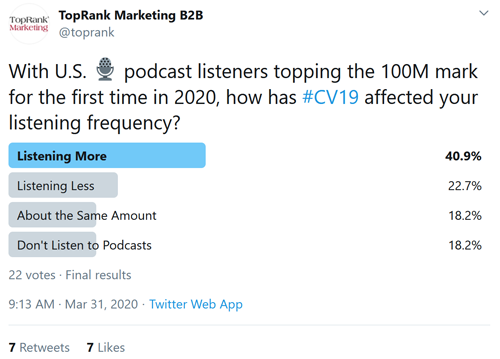
With numerous studies showing that streaming music ads were booming in 2019, we wondered what B2B marketers planned for 2020, and 50 percent of our Twitter poll respondents said that they had no streaming ad plans for the year, while 25 percent said they planned to implement more streaming ads, 16 percent fewer of them, and 8 percent about the same.
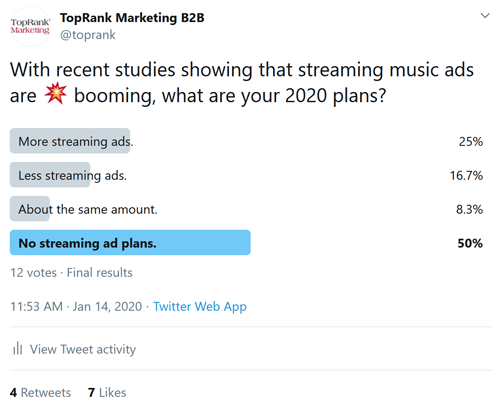
Content creation efforts are also shifting in 2020, and we asked B2B marketers to share which stage of the customer journey they are focusing on the most.
47 percent of respondents said that generating awareness was where they were placing the greatest focus, followed by brand advocacy at 35 percent, consideration and intent at 11 percent, and evaluation and purchase at 5 percent.
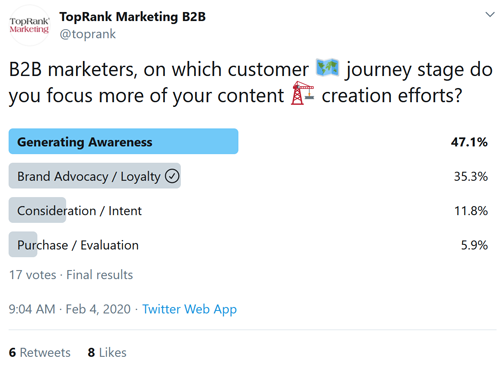
We asked our LinkedIn and Twitter followers to chime in on the ideal length of time a B2B influencer marketing program should run for maximum effectiveness, and the majority of our savvy followers chose always-on and ongoing programs — 73 percent of our LinkedIn respondents and 64 percent of our Twitter respondents.
Influencer marketing programs encompassing at least two campaigns was the second most popular choice, the choice of 21 percent of LinkedIn respondents and 18 percent of our Twitter respondents.
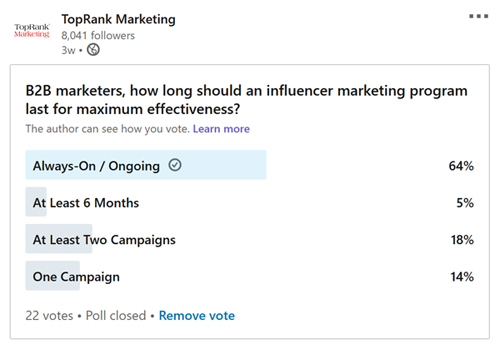
We asked B2B marketers which area of marketing they were the most likely to increase focus on during the global health crisis, and topping the list was influencer marketing at 35 percent, followed by content marketing at 30 percent, search marketing at 20 percent, and email marketing, which garnered 12 percent of the poll responses.
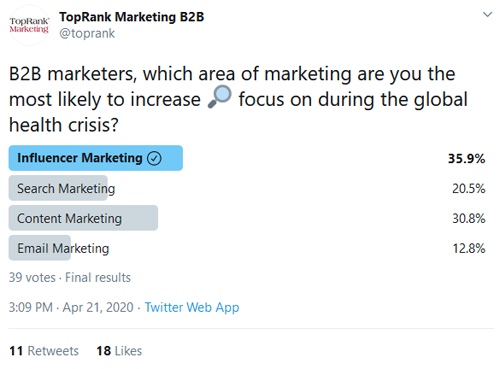
We were also curious how the pandemic has affected the volume of work B2B marketers have done with influencers. The greatest number of our respondents — some 36 percent — said that their volume of work with influencers had increased, followed by 32 percent who said that they didn’t use influencers, 24 percent who found that the volume of work was about the same, while 8 percent noted that the volume decreased.
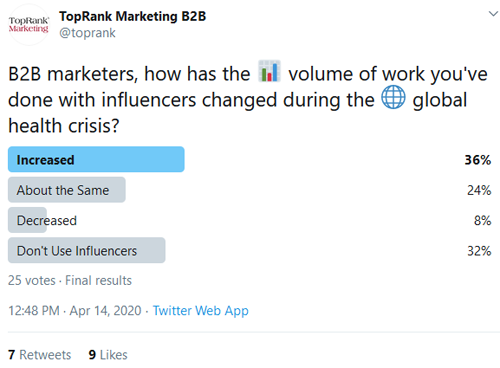
Keeping your finger on the pulse of your audience — whether it’s from poll results, surveys, questionnaires or other forms of feedback — goes a long way when it comes to making your marketing efforts authentic, and will help ensure that your communication is a two-way street and not just a publish-and-forget effort.
We hope you’ve found this glimpse into some of our own poll results helpful as you navigate the sometimes murky marketing waters 2020 has given us. Let us know your thoughts by voting in our current weekly poll about Instagram’s new short-form video offering, Reels — you’ll find it on LinkedIn here and on Twitter here.
You can learn more about poll data and statistics, and how to get more from audience feedback in every form by taking a look are some of the related articles we’ve written on the subject, such as the five listed here:
* LinkedIn is a TopRank Marketing client.
The post Show Me The Numbers: 20 B2B Marketing Insights From Audience Poll Data appeared first on Online Marketing Blog – TopRank®.


What can poll results tell B2B marketers about a year unlike any other, and how can this valuable audience data help us refine our marketing strategy as we push towards 2021?
For more than a year we’ve run weekly social media polls on our Twitter profile, and for several months now have simultaneously also placed a weekly user poll on our LinkedIn* page.
We wanted to share some of the fascinating insights you have shared with us in the form of results from our polls, in order to see the trends that have emerged during this unprecedented year.
Let’s look at trends in social media communications, how marketing is changing in 2020, and the rising effectiveness of B2B influencer marketing, all through the lens of poll-derived feedback.
How quickly do we expect a response from a brand when we ask a question publicly on social media?
The majority marketers we polled expect to hear back from a brand within 24 hours, with 61 percent of respondents on LinkedIn expecting a reply within a day, 24 percent within one hour, and 16 percent by the end of the workday.
Twitter respondents voiced similar sentiments, with 38 percent looking to get a reply from a brand within 24 hours, 33 percent by the end of the current workday, and 21 percent within an hour.
If you’re not answering social media inquiries within 24 hours you may come under fire, as not even one respondent to our poll said that they expect brands to take longer than a day to reply.

We also asked the same question for a different form of online communications, curious about expectations when sending an old-fashioned email to a brand.
50 percent of our Twitter poll respondents said that they expected an email reply within 24 hours, mostly echoing the expectations for public social media questions. 22 percent said they expected brands to reply by the end of the workday, 18 percent within a week — a notable difference from social media queries — and just 9 percent within an hour.

What drives people who have already taken the time and effort to follow a brand on social media to later unfollow them, and what messages can we learn from these mistakes?
When we asked this question in a poll, our LinkedIn respondents said the top reason they unfollow brands comes down to posting poor quality content, followed by irrelevant content and brands that post too much content. Just two percent of respondents said that they unfollow brands that don’t post enough content.
44 percent of our Twitter respondents said that irrelevant content was their top reason for unfollowing a brand, followed by poor quality content at 33 percent, and too much content at 22 percent.

We also ran a poll asking how the ephemeral stories format would fare on LinkedIn if the platform were to make its test of the post type a permanent part of the service. 33 percent of respondents said that LinkedIn Stories would be a great addition to the platform, while 25 percent felt it would be a good match. 25 percent also said that it would be an unlikely match, and 16 percent noted that the stories format would be a poor match for LinkedIn.

We were also curious how B2B marketers are using experiential content in 2020. 58 percent of our Twitter poll respondents said that they expected to incorporate experiential content very frequently into their marketing efforts during 2020, followed by 41 percent who planned to do so somewhat frequently.

Experiential content is playing a greater role in B2B marketing efforts in 2020, which I looked at in “What B2B Marketers Need to Know About Experiential Content,” and our Nick Nelson examined recently in “How to Hit a Marketing Home Run with Experiential Content.”
How B2B marketers communicate is constantly shifting as new technologies become available and gain wider adoption. We asked our Twitter followers who use chatbots or other forms of messaging featuring artificial intelligence (AI) to chime in on how the technology has performed for them.
49 percent of B2B marketers who responded said that chatbots and AI-assisted technology has performed better than expected, yet 42 percent noted that the technology has under-performed, while 14 percent found that it performed as they had expected.

We were curious what our audience of B2B marketers on Twitter felt the most effective length of time might be when it comes to virtual meetings.
58 percent of respondents said that 30 minutes was the optimal length of time for effective virtual meetings, while 17 percent felt that 15 minutes or less works best, with 17 percent also noting that 45 minutes is the most effective, followed by just 5 percent who said an hour was best.

Another part of marketing communications is user feedback, reviews, and testimonials, and we asked our Twitter followers to share how often they use positive reviews in their marketing efforts.
47 percent of respondents said that they use positive reviews in their marketing efforts occasionally, however 23 percent noted that they never do, followed by 17 percent who said that they always do, and 11 percent who do so frequently.

Speaking of email, we also wondered when B2B marketers prefer to receive monthly newsletters. 45 percent of our respondents said they prefer the first of the month, followed by 27 percent who are fond of mid-month newsletters, 18 percent who prefer a time early in the month, and 9 percent who want to see newsletters arrive at the end of the month.

The use of emojis in social media messaging was an area of contention among our poll respondents. 35 percent said that emoji were somewhat effective, while the same number noted their use to rarely be effective. 17 percent said emoji were extremely effective, and some 11 percent noted that they never use them.

The global health crisis has changed the face of marketing events in 2020, as nearly all conferences have made the jump to virtual events, as I wrote about recently in “17+ Top Virtual Marketing Conferences for Summer 2020 & Beyond.”
Are B2B marketers planning to attend newly-virtual events, and if so how many?
We asked our LinkedIn and Twitter users how many virtual marketing events they planned to attend over the final five months of 2020.
Most respondents said that they will attend between one and five virtual marketing events, while the second most frequent choice was those who said they won’t be attending a single virtual event, followed by those who plan to attend between six and 10.

Virtual events and webinars are undoubtedly seeing an unexpected golden age this year, and we’ve explored how to best utilize them, in “How B2B Marketers Can Get the Most Out of Webinars in 2020.”
[bctt tweet=”“One great way to promote the webinar, and focus your content at the same time, is to poll your audience via social media. Ask for their thoughts on your topic. Ask what they most want to know about it.” @NiteWrites” username=”toprank”]We wanted to find out what the biggest pandemic pain points have been for B2B marketers, and among those answering our LinkedIn poll 64 percent said that a decrease in budget or business has been the top challenge, followed by the difficulty in engaging customers at 36 percent.
46 percent of Twitter respondents also revealed that falling budgets and business were their top pain points, followed by engaging customers at 38 percent and remote work issues for some 15 percent of marketers.

63 percent of poll respondents said that they have used their time during the pandemic to learn new marketing skills online, while 18 percent said that they planned to do so.

54 percent of B2B marketers we polled on Twitter said that they either already use a digital asset management (DAM) solution in their marketing stack or plan to implement one, while 45 percent didn’t use a DAM.

If you aren’t familiar with how DAM can help B2B marketers, I looked into the issue in “Why B2B Marketers Should Give a DAM: Top Tips on Digital Asset Management.”
With U.S. podcast listeners topping the 100 million mark for the first time in 2020, we wondered how the global health crisis has affected listening frequency among B2B marketers.
40 percent of our Twitter respondents said that they have been listening to more podcasts during the pandemic, with 22 percent noting that they’ve listened to fewer, 18 percent about the same amount, and another 18 percent who said they don’t listen to podcasts.

With numerous studies showing that streaming music ads were booming in 2019, we wondered what B2B marketers planned for 2020, and 50 percent of our Twitter poll respondents said that they had no streaming ad plans for the year, while 25 percent said they planned to implement more streaming ads, 16 percent fewer of them, and 8 percent about the same.

Content creation efforts are also shifting in 2020, and we asked B2B marketers to share which stage of the customer journey they are focusing on the most.
47 percent of respondents said that generating awareness was where they were placing the greatest focus, followed by brand advocacy at 35 percent, consideration and intent at 11 percent, and evaluation and purchase at 5 percent.

We asked our LinkedIn and Twitter followers to chime in on the ideal length of time a B2B influencer marketing program should run for maximum effectiveness, and the majority of our savvy followers chose always-on and ongoing programs — 73 percent of our LinkedIn respondents and 64 percent of our Twitter respondents.
Influencer marketing programs encompassing at least two campaigns was the second most popular choice, the choice of 21 percent of LinkedIn respondents and 18 percent of our Twitter respondents.

We asked B2B marketers which area of marketing they were the most likely to increase focus on during the global health crisis, and topping the list was influencer marketing at 35 percent, followed by content marketing at 30 percent, search marketing at 20 percent, and email marketing, which garnered 12 percent of the poll responses.

We were also curious how the pandemic has affected the volume of work B2B marketers have done with influencers. The greatest number of our respondents — some 36 percent — said that their volume of work with influencers had increased, followed by 32 percent who said that they didn’t use influencers, 24 percent who found that the volume of work was about the same, while 8 percent noted that the volume decreased.

Keeping your finger on the pulse of your audience — whether it’s from poll results, surveys, questionnaires or other forms of feedback — goes a long way when it comes to making your marketing efforts authentic, and will help ensure that your communication is a two-way street and not just a publish-and-forget effort.
We hope you’ve found this glimpse into some of our own poll results helpful as you navigate the sometimes murky marketing waters 2020 has given us. Let us know your thoughts by voting in our current weekly poll about Instagram’s new short-form video offering, Reels — you’ll find it on LinkedIn here and on Twitter here.
You can learn more about poll data and statistics, and how to get more from audience feedback in every form by taking a look are some of the related articles we’ve written on the subject, such as the five listed here:
* LinkedIn is a TopRank Marketing client.
The post Show Me The Numbers: 20 B2B Marketing Insights From Audience Poll Data appeared first on Online Marketing Blog – TopRank®.
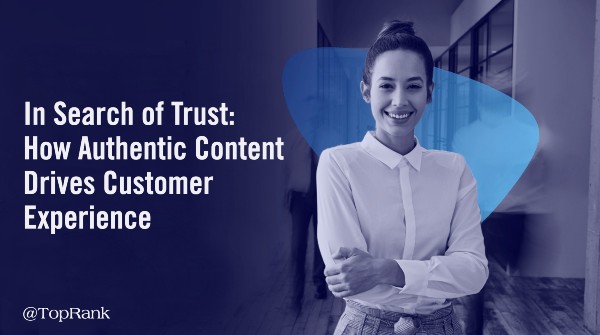

The experience customers have through marketing content can be one of the most important differentiators for brands today.
And yet 58% of B2B buyers don’t not believe claims made by the vendors they most recently bought from (TrustRadius).
It’s hard to create a great experience if customers don’t trust brand communications.
Trust is the gateway to influence perceptions, behaviors and actions and brands that want to succeed in the uncertain environment of today’s digital world need to double down on building trust with their customers. But how?
Today’s increasingly digital buyers have high expectations of the companies they do business with: buyers want personalized and relevant information, they want a consistent experience across channels, they want confidence in the brand as a company that cares about privacy, their customers and the community.
Meeting these expectations has been a challenge. From fake news to privacy issues to deep fakes, the digital world has become an uncertain source of information for consumers.
Tired of information overload, sales focused brand messaging and unremarkable content, 86% of customers say authenticity is important when deciding what brands they like and support (Stackla – The Consumer Content Report: Influence in the Digital Age).
Customers want what’s real. They want to trust and be confident about their decisions.
While there’s a lot of information and even misinformation about content marketing and what it means for business communicators, there’s hope in building trust and influence by creating great customer experiences with authentic content.
To help marketers better understand how brands are winning customer hearts, minds, and trust with authentic content experiences here are 5 important steps:
In order for marketing to have the support it needs to be successful externally with customers, marketing needs to be credible inside the organization. Unfortunately, 80% of CEOs don’t trust marketers but 91% do trust CIOs and CFOs (Fournaise Group).
To earn C-level trust, marketers must identify the key business problems faced by the business and make the connection to how marketing can help solve those issues. More importantly, marketing needs to provide clear direction about how and show credible reporting about impact. Ensuring credibility internally means promoting your wins to internal stakeholders. Make sure everyone from department heads to the C-suite are aware of the results that you are delivering to the business bottom line.
As marketers use content marketing integrated across channels to create “best answer” experiences for customers, marketers must also become the best answer for business growth inside the company by focusing on and communicating what matters to the business – not fluffy marketing promises with ambiguous correlations to the impact on the business.
Word of mouth and advocacy continue to represent important sources of trust and influence for brands. Marketers need to engage customers for reviews, ratings and even user generated content. As I’ve often said,
“If you want your content to be great, ask your customers to participate.”
Build credibility and influence with customers by engaging them and making them part of the narrative that builds trust about your brand where buyers are looking.
Every brand has a story to tell and to help make that story relevant, interesting and effective amongst buyers who are probably ignoring most brand communications, marketers can engage with relevant industry influencers. What makes someone influential is that they have the trust and attention of your customers. What better way to add credibility to your brand content than to collaborate with people who already have that credibility?
Virtually any kind of external content that brands create can consider influencer collaboration to make it more credible, relevant, engaging and capable of actually reaching the audience it is intended for. Authenticity is essential for influencer collaborations to work so it’s important that marketers do their due diligence with influencers through proper identification, qualification and engagement best practices.
Most marketers don’t have all the content creation resources they need to create the kind of content that drives customer experience. Engaging influencers to collaborate on content is a great start. But to truly build authenticity and content experiences that matter, customers can be engaged as well. User generated content is not for everyone, but when customers can contribute their voices to brand content, it adds a level of authenticity and trust that most marketing departments are able to on their own.
Employees are another important source of authentic content for brands, whether it’s telling stories about the impact those employees have on the lives of customers or by enlisting employees to help tell the brand story.
Creating trust with authentic content experiences must be a measurable exercise. Beyond share of voice and brand sentiment metrics, marketers must pay attention to measuring the effectiveness of content through the customer journey.
At a minimum, marketers must understand the the impact in these key areas:
Beyond these important steps towards more effective content marketing that drives trust are the influence traits brands must have to build trust:
Purpose: “In this time of turmoil people are turning to brands as islands of stability.” Richard Edelman. How will the world be different after you’re successful doing what you do? How does that narrative translate into your marketing?
Relevance: Use data to understand your internal/external customer and create compelling, useful content experiences that matter. Leverage the voices of your customers, prospects, and those they trust to help add credibility and context to your message.
Reach: Become “the best answer” for your customers with content that is easy to find and exists in context wherever buyers engage.
Resonance: Understand audience motivations through the buyer journey to inform messaging that “clicks” and inspires action and makes real, measurable business impact.

I hope you can join me at the virtual IABC Minnesota Convergence Summit conference this week where I will be giving the opening keynote on Wednesday August 12th at 4pm: In Search of Trust: How Authentic Content Drives Customer Experience. I’ll be digging into the current state of content marketing as well as sharing examples of brands walking the talk on authenticity and content marketing.
The post In Search of Trust: How Authentic Content Drives Customer Experience appeared first on Online Marketing Blog – TopRank®.

According to research by GatherUp, 71% of customers are more likely to do business in stores that require face masks. The latest research points to a growing health concern among patrons over possibly contracting COVID-19 as businesses open up.
The research analyzed by some 40,000 reviews by shoppers points to the need for businesses to heed customers’ health concerns. Because more than half (54.4%) of shoppers say they are more likely to shop at a business with strict mask policies.
In contrast, 27% say a strict mask policy would not impact their willingness to shop there. Surprisingly 18% of those shoppers would be less inclined to shop at a business that enforces the wearing of masks. According to GatherUp, the small minority of those who abhor wearing a mask do so for political reasons.
The research also notes a drop in ratings for major brands during the post COVID era. Major brands such as Home Depot, Walmart, Costco and even Dominos saw a drop in their ratings by customers. Comparing reviews from 90 days before and after COVID, brand experience reviews saw a downward trend. Home Depot took the biggest loss dropping by 0.3 while Walmart, Costco, and Domino’s dropped 0.1 during the period.
Despite the debate across the nation over wearing masks, the research is clear on what shoppers want. Over 80% of US adults are either more likely or equally likely to do business if the business enforces stronger masking policies.
Men relative to women more frequently said they were less likely to do business with companies that had strict mask enforcement. A quarter (25.2%) of men say they are less likely to shop in establishments with mask polices compared to 18% of women.
Perceptions also vary among age groups. Those over 45 years of age say not having mask policies could be a factor in their shopping preference. With 19.6% saying they were less likely to do business in establishments that enforce masking. Of those between 18 to 45 years of age, almost a quarter (23.4%) say masks could be a deal-breaker. However, the majority of both those above and below 45 years of age are more inclined to patron establishments with mask codes. With 74.2% of those above 45 saying they would likely shop while 68.1% under 45 years saying the same.
Location wise the survey shows distinct differences between regions across the United States. The Northeast was quite a bit more likely to do business if strict masking protocols were followed with 80.6% supporting masking. The Midwest was somewhat lukewarm with 68.4% saying they don’t mind stricter protocols.
Irrespective of your political views the safety of both customers and staff should be of paramount importance. A safe and healthy environment not only protects employees from injury and illness but maintains productivity. It lowers healthcare costs, reduces absenteeism, raises morale and mitigates staff turnover.
Besides being the right thing to do, businesses are legally required to provide a safe environment for their customers. Even in times when there is push back over protocols that might be unpopular. There is no compromise over safety.
Safety protocols such as wearing masks are important for everyone’s safety. These protocols help to ensure employees and customers do not injure or risk their health while conducting business. Safety protocols from the perspective of the business help maintain certification, avoid legal liabilities and of course improve operations. Customers who know that a business does not compromise with their health and safety are put at ease. They are inclined to do business with them simply because they are assured, they are not put at risk.
COVID-19 has changed the world and our way of life. In these uncertain times, it is even more important for businesses to continue to provide services safely. Business owners need to take the lead in terms of educating both staff and customers of health risks. They should also clearly communicate the safety protocols are meant for the benefit of everyone. Your relationship with your customers isn’t simply transactional. It is based on mutual understanding and concern for each other’s welfare. As businesses open up, the key is to adapt to the new way of doing business and making safety a priority.
Image: Depositphotos.com
This article, “71% of Consumers More Likely to Shop at Stores Requiring Face Masks” was first published on Small Business Trends

The second Zoho Educational Webinar is titled, Establishing Your Brand Story and Voice. This is part of a series of free webinars designed to provide users with some key tools for today’s digital ecosystem.
The first one, which will take place on August 26 starting from 1-1:45 p.m. EST, is about Domain and Web Hosting. The follow up will teach you how to find, incorporate, and use your brand’s voice throughout your website.
According to Zoho, the goal is to increase website traffic, improve customer engagement, and drive brand loyalty. As you learn more skills from each session, you will have fundamental knowledge about getting your business online and growing your brand.
The good news is there are more resources than ever to establish the story of your brand and get your voice out there. With some basic knowledge and of course hard work you can launch your own digital presence and thrive.
Establishing Your Brand Story and Voice is going to take place on September 20 starting from 1-1:45 p.m. EST.
Click the red button and register now.
 Small Business Expo 2020 – BOSTON
Small Business Expo 2020 – BOSTON
August 13, 2020, Boston, MA
Small Business Expo is the most anticipated business-to-business networking & educational event, trade show & conference for business owners, entrepreneurs, start-ups, decision-makers or anyone who works for a small business or is interested in starting a Small Business. Small Business Expo is a FREE one-day event to attend for small businesses to network, attend great business-growth workshops, build new business relationships, exchange ideas, shop from new vendors and learn from leading industry experts.
 Educational Webinar: Setting up Your Website
Educational Webinar: Setting up Your Website
August 26, 2020, Online
Learn the basics of choosing and registering a domain name. We’ll also go over web hosting options so you can decide what’s best for your business.
 Educational Webinar: Establishing Your Brand Story
Educational Webinar: Establishing Your Brand Story
September 2, 2020, Online
Learn how to find, incorporate, and use your brand’s voice throughout your website to increase website traffic, improve customer engagement, and drive brand loyalty.
 Educational Webinar: Elements of Website Design
Educational Webinar: Elements of Website Design
September 9, 2020, Online
Join us to learn about fonts, color schemes, and gain a basic understanding of visual hierarchy.
 Educational Webinar: Converting Visitors to Leads
Educational Webinar: Converting Visitors to Leads
September 16, 2020, Online
Learn best practices for optimizing webforms and CTAs in order to maximize the number of visitor conversions on their site.
 Getting Started with Zoho One
Getting Started with Zoho One
September 23, 2020, Online
In this presentation, we will walk through an overview of Zoho One using real case studies from Zoho customers to demonstrate different ways Zoho One can support your business.
 Small Business Expo 2020 – PHILADELPHIA
Small Business Expo 2020 – PHILADELPHIA
October 28, 2020, Philadelphia, PA
Small Business Expo is a FREE one-day event to attend for small businesses to network, attend great business-growth workshops, build new business relationships, exchange ideas, shop from new vendors and learn from leading industry experts. If you are serious about starting or growing your business, Small Business Expo is a “must attend” event. Small Business Expo is the #1 Business to Business Networking Event for business owners, entrepreneurs, start-ups, decision-makers or anyone who works for a small business or is interested in starting a Small Business.
 LinkUpConferenceShow
LinkUpConferenceShow
November 12, 2020, Online
LinkUpConferenceShow (LUCS) is a digital networking conference that merges the incredibly dynamic worlds of tech and comedy to provide informative and personalized networking opportunities designed to help executives, entrepreneurs, business leaders and tech professionals grow and scale their businesses. LUCS is the tech conference that combines Silicon Valley insights with New York’s nonstop energy to bring the technology community a totally new virtual experience designed to inspire, engage and entertain.
This weekly listing of small business events, contests and awards is provided as a community service by Small Business Trends.
You can see a full list of events, contest and award listings or post your own events by visiting the Small Business Events Calendar.
Image: zoho.com
This article, “Learn to Give Your Brand a Voice at Upcoming Zoho Event” was first published on Small Business Trends